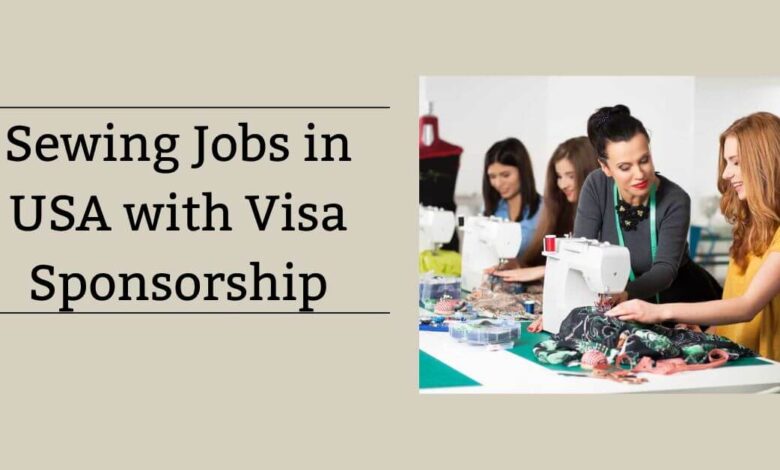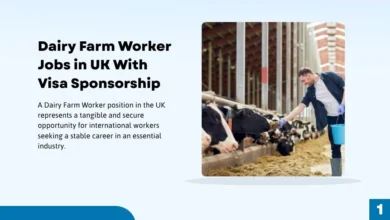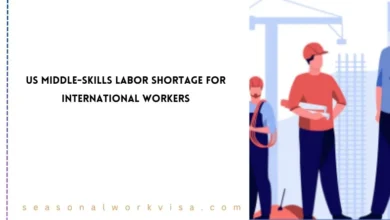Sewing Jobs in USA with Visa Sponsorship 2025 – Apply Now

In its most basic form, sewing is the process of affixing materials through the use of threads that are either manually or mechanically executed. A wide variety of occupations in the United States industry of textile, apparel, and fashion, as well as manufacturing and customized stitching professions, are included in sewing employment.
The potential for skilled laborers in these professions is substantial. We will examine all the pertinent information regarding embroidery positions in the United States.
Details:
- Job Title: Sewing Professional (Various Roles)
- Location: United States (Multiple locations depending on employer)
- Visa Sponsorship: Available (H-2B, EB-3, or other relevant work visas)
Requirements:
- Educational Background: The employment of SOC 261 occasionally necessitates a high school diploma or a general equivalency diploma (GED).
- Experience: Work experience in the textile industry, fashion design, or stitching may prove advantageous.
- Technical Proficiency: The candidate must possess a comprehensive understanding of the operation of stitching machines, the cutting of materials, and the manipulation of a variety of fabrics. Additionally, it is imperative to be acquainted with measurements, patterns, and modifications.
- Attention to Detail: In sewing positions, particularly those that involve fashion designer wear or made-to-order apparel, the degree of delicacy and closeness of work are crucial.
Benefits of Jobs:
- Job Demand: The demand for experienced sewing professionals is consistent, particularly in industries such as upholstery, fashion, and manufacturing, which offer long-term opportunities and job security.
- Competitive Wages: Sewing careers in the United States provide competitive wages, particularly for individuals with specialized experience or advanced skills in fields such as industrial sewing, leatherwork, or costume design.
- Diverse Employment Prospects: Sewing professionals have the opportunity to secure employment in a diverse range of industries, such as textile manufacturing, fashion design, interior design (upholstery), automotive (car seat manufacturing), and medical textiles.
- Flexibility of Work Arrangements: Numerous sewing positions provide the opportunity to work from home, freelance, or on a part-time basis. This is particularly advantageous for individuals who are interested in achieving a more harmonious work-life integration.
- Creative Outlet: Sewing is a profession that is highly creative and enables individuals to express themselves through design and craftsmanship, making it a fulfilling career for those who have a passion for fashion or handmade products.
- Skill Development: Sewing positions offer the chance to consistently refine and improve technical abilities, such as pattern making, embroidery, alterations, and fabric manipulation, which keeps the work engaging and stimulating.
- Career Advancement: Sewers who are proficient in their craft may progress to more advanced or specialized positions, including production manager, lead tailor, or seamstress. They may also establish their own sewing or tailoring enterprises.
- Self-Employment Opportunities: A significant number of sewing professionals elect to operate as freelancers or establish their own businesses, providing custom tailoring, alterations, or garment repair services. This approach provides them with a higher degree of autonomy and control over their work.
Duties:
- Fabric Cutting and Measuring: It is crucial to adhere to the correct cutting and measuring procedures during the production process to ensure that the final product is manufactured to the correct specifications.
- Reading and Following Patterns: In order to manufacture specific textiles or garments, tailors and seamstresses must possess a comprehensive understanding of pattern instructions, layouts, and any other technical drawings.
- Altering Clothing: A variety of sewing jobs necessitate the modification of clothing, including hemming, resizing, or mending garments that have been damaged in some manner.
- Quality Control: Some of the job responsibilities include ensuring that the products are free of defects and that the seams have the appropriate number of stitching, as well as any visible loose threads.
Check Also: Embroidery Machine Operator Jobs in USA – Work Visa
Salary Expectations:
The compensation for sewing jobs in the United States is contingent upon factors such as the job description, experience, and the location of the job. Sewing professionals can anticipate an average salary of:
- Entry-Level Positions: $25,000 to $35,000 annually
- Experienced Sewers: This amount is typically between $35,000 and $50,000 annually.
- Specialized Positions (e.g., Pattern Makers, Tailors): The annual salary ranges from $40,000 to $60,000.
- Supervisory Positions: an annual salary of fifty to seventy thousand US dollars
Types of Sewing Jobs in USA with Visa Sponsorship:
- Tailor: A tailor is a professional who creates clothing for specific clients, modifies it by adding or subtracting sizes, and repairs it.
- Seamstress/Seamster: Sewers, tailors, or stitchers who sew and join clothing, accessories, or household textiles.
- Pattern Maker: Pattern makers are responsible for the creation of apparel patterns in accordance with the designer’s vision. They are also engaged in the production and preparation of garments.
- Costume Designer: Specialty costume designers, such as theatrical costume makers and tailors, are responsible for the design and stitching of costumes for stage burlesque, motion pictures, and other events.
- Upholsterer: Sewers are responsible for the fabrication and construction of furniture, transport vehicle seats, and other similar products.
- Embroidery Machine Operator: These employees employ embroidering machines to incorporate detail works, insignia, or brand logo designs into apparel and fashion fabrics.
- Garment Assembler: Garment assemblers are manufacturing laborers who are responsible for the sewing and assembly of garment components or other related accessories.
- Textile Worker: This industry employs a variety of individuals, including weavers, knitters, and spinners, as well as tailors who transform fabrics into practical items and quality controllers.
- Sewing Supervisor: Sewing supervisors are responsible for coordinating sewing sub-groups to ensure that the established production and quality objectives are met.
- Industrial Sewing Machine Operator: These professionals operate industrial sewing machines in a production environment and sew through thick fabrics, such as canvas or leather.
Application Process:
- Job search platforms: These platforms include social networks, job search websites, forums, employment-related boards, company websites, and traditional career sites.
- Create a Resume and Portfolio: Develop a resume that highlights your sewing experience, qualifications, abilities, and accomplishments. If it is feasible, include the portfolio of the most exceptional work completed thus far.
- Apply for Jobs Online: You may submit your resume and cover letter directly through the company’s website, currently available online employment search sites, or employment agencies that specialize in textile and sewing positions.
Frequently Asked Questions:
How much does a sewing machine cost in the USA?
Modern sewing machines provide numerous features for sewers of all skill levels, with prices ranging from $150 to thousands. But how much does a sewing machine that can meet most of your sewing project needs cost? You shouldn’t have to pay more than about $400 for a reliable sewing machine.
What skills come from sewing?
On top of that, sewing improves your dexterity and fine motor skills by 1) getting you used to working with small items, such as thimbles, needles, thread, bobbins, etc., and 2) getting you used to working with a machine and guiding it in the direction you want it to go to make the proper stitches.
Is sewing a viable career?
A career in sewing offers a wealth of opportunities, measured by the quality of craftsmanship and the financial stability it can provide.




